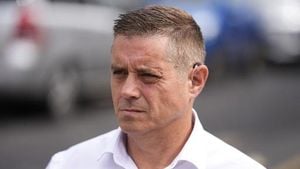Widespread understaffing at U.S. airport towers has brought renewed scrutiny on the safety of air traffic control operations following recent tragic incidents.
According to data from the CBS News analysis of FAA statistics, less than 10% of the nation’s airport towers have enough air traffic controllers to meet the standards set by the Collaborative Resource Working Group, which includes the Federal Aviation Administration (FAA) and the controllers’ union. This imbalance has heightened concerns about the potential for near-miss incidents and operational errors, particularly as travel demand has surged since the COVID-19 pandemic.
The issue garnered significant attention after the midair collision on January 29, 2025, between an American Airlines flight and a Black Hawk Army helicopter near Reagan National Airport, which resulted in the tragic loss of 67 lives. Preliminary reports from the FAA revealed troubling staffing conditions at the DCA air traffic control tower on the night of the crash. Sources cited by CBS News indicated only one air traffic controller was managing both helicopters and planes—a situation described as "not normal for the time of day and volume of traffic." Typically, two controllers handle such operations, especially during peak times.
The staffing crisis is not isolated to DCA; nationwide, about 72% of fully trained controllers are currently filling ATC positions, falling short of the working group’s target of approximately 14,600 controllers. When accounting for trainee controllers, the number rises to 87%, yet the country remains significantly short of approximately 3,000 to 4,000 trained controllers. The FAA's report noted the disruption caused by the pandemic hampered recruitment and training efforts, citing, "At the onset of the pandemic, certain activities were eliminated or significantly reduced at FAA’s air traffic control facilities. This significantly impacted the development of fully trained controllers."
The stakes could not be higher. With over 90% of U.S. airport towers understaffed, controllers are called to work more frequently, leading to fatigue and stress. This is particularly concerning, as there is significant evidence linking human error to these pressures. The FAA has recorded multiple near-miss incidents and runway incursions, with reports citing over 1,757 airspace incursions for fiscal year 2024 alone. The cumulative stress from prolonged overtime and urgent workloads has raised alarms about the viability of maintaining safety standards.
The National Air Traffic Controllers Association (NATCA), which advocates for air traffic controllers, has been vocal about these issues. Nick Daniels, the union’s president, stressed the consequences of the resignation program initiated under the Trump administration, stating it could severely deplete already strained resources. "It is not yet clear how this resignation program would affect ATC workers, but losing experienced personnel during this recognized staffing shortage is deeply concerning," Daniels said.
The safety of the flying public jumps to the forefront amid this serious crisis. Experts assert the factors leading to workforce shortages cannot be overlooked. Investigative reports have connected these staffing issues to multiple factors: the exacerbation of existing shortages by the pandemic, inadequate funding and support for recruitment initiatives, and the directly related increased risk of mismanagement due to the pressure on controllers.
Educational policies and potential solutions must be addressed urgently. Experts recommend increasing budget allocations for recruitment and training to ramp up the pipeline of fully trained controllers. There is also vast agreement within the aviation community on the need to modernize infrastructure and technology to alleviate demanding workloads and support those on the ground keeping air traffic operations safe. Without prompt action, the path seems grim.
The ramifications of understaffing are vividly clear following events like the recent collision, underscoring the need to prioritize aviation safety through adequate staffing levels, efficient training programs, and sufficient technological support for air traffic controllers. The promise of safe skies rests heavily on addressing these systemic challenges.



